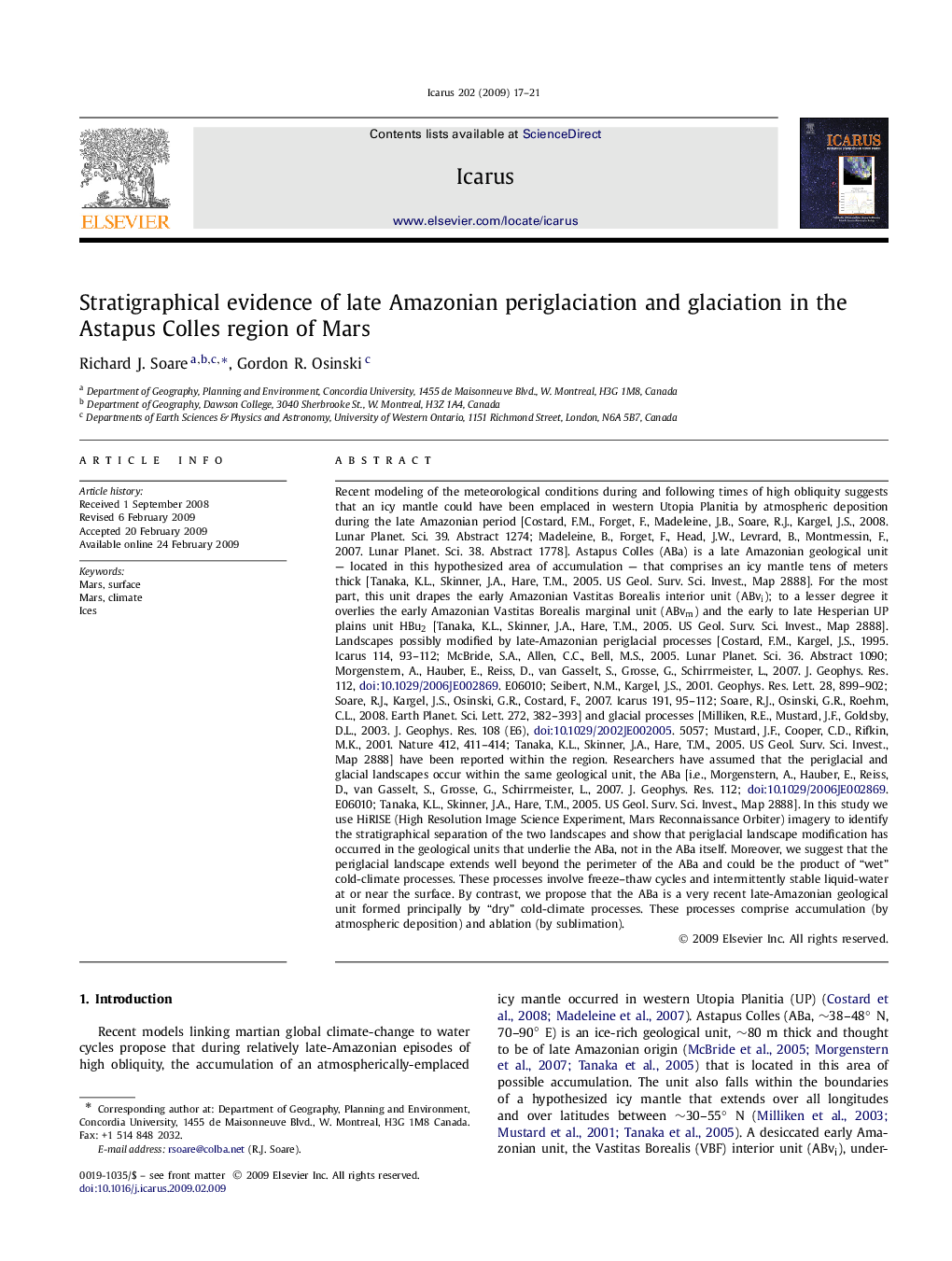| کد مقاله | کد نشریه | سال انتشار | مقاله انگلیسی | نسخه تمام متن |
|---|---|---|---|---|
| 1775096 | 1021184 | 2009 | 5 صفحه PDF | دانلود رایگان |

Recent modeling of the meteorological conditions during and following times of high obliquity suggests that an icy mantle could have been emplaced in western Utopia Planitia by atmospheric deposition during the late Amazonian period [Costard, F.M., Forget, F., Madeleine, J.B., Soare, R.J., Kargel, J.S., 2008. Lunar Planet. Sci. 39. Abstract 1274; Madeleine, B., Forget, F., Head, J.W., Levrard, B., Montmessin, F., 2007. Lunar Planet. Sci. 38. Abstract 1778]. Astapus Colles (ABa) is a late Amazonian geological unit — located in this hypothesized area of accumulation — that comprises an icy mantle tens of meters thick [Tanaka, K.L., Skinner, J.A., Hare, T.M., 2005. US Geol. Surv. Sci. Invest., Map 2888]. For the most part, this unit drapes the early Amazonian Vastitas Borealis interior unit (ABvi); to a lesser degree it overlies the early Amazonian Vastitas Borealis marginal unit (ABvm) and the early to late Hesperian UP plains unit HBu2 [Tanaka, K.L., Skinner, J.A., Hare, T.M., 2005. US Geol. Surv. Sci. Invest., Map 2888]. Landscapes possibly modified by late-Amazonian periglacial processes [Costard, F.M., Kargel, J.S., 1995. Icarus 114, 93–112; McBride, S.A., Allen, C.C., Bell, M.S., 2005. Lunar Planet. Sci. 36. Abstract 1090; Morgenstern, A., Hauber, E., Reiss, D., van Gasselt, S., Grosse, G., Schirrmeister, L., 2007. J. Geophys. Res. 112, doi:10.1029/2006JE002869. E06010; Seibert, N.M., Kargel, J.S., 2001. Geophys. Res. Lett. 28, 899–902; Soare, R.J., Kargel, J.S., Osinski, G.R., Costard, F., 2007. Icarus 191, 95–112; Soare, R.J., Osinski, G.R., Roehm, C.L., 2008. Earth Planet. Sci. Lett. 272, 382–393] and glacial processes [Milliken, R.E., Mustard, J.F., Goldsby, D.L., 2003. J. Geophys. Res. 108 (E6), doi:10.1029/2002JE002005. 5057; Mustard, J.F., Cooper, C.D., Rifkin, M.K., 2001. Nature 412, 411–414; Tanaka, K.L., Skinner, J.A., Hare, T.M., 2005. US Geol. Surv. Sci. Invest., Map 2888] have been reported within the region. Researchers have assumed that the periglacial and glacial landscapes occur within the same geological unit, the ABa [i.e., Morgenstern, A., Hauber, E., Reiss, D., van Gasselt, S., Grosse, G., Schirrmeister, L., 2007. J. Geophys. Res. 112; doi:10.1029/2006JE002869. E06010; Tanaka, K.L., Skinner, J.A., Hare, T.M., 2005. US Geol. Surv. Sci. Invest., Map 2888]. In this study we use HiRISE (High Resolution Image Science Experiment, Mars Reconnaissance Orbiter) imagery to identify the stratigraphical separation of the two landscapes and show that periglacial landscape modification has occurred in the geological units that underlie the ABa, not in the ABa itself. Moreover, we suggest that the periglacial landscape extends well beyond the perimeter of the ABa and could be the product of “wet” cold-climate processes. These processes involve freeze–thaw cycles and intermittently stable liquid-water at or near the surface. By contrast, we propose that the ABa is a very recent late-Amazonian geological unit formed principally by “dry” cold-climate processes. These processes comprise accumulation (by atmospheric deposition) and ablation (by sublimation).
Journal: Icarus - Volume 202, Issue 1, July 2009, Pages 17–21